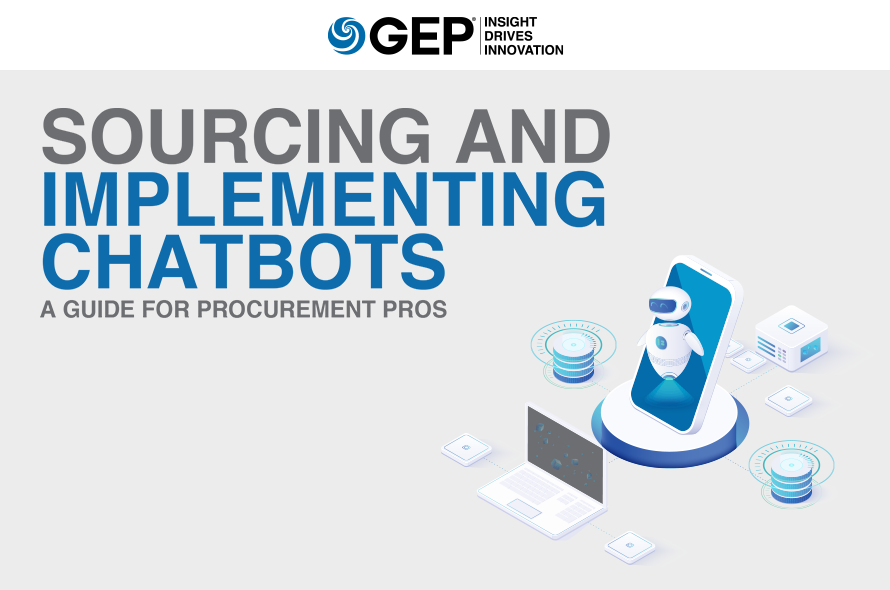People don’t exactly love dealing with insurance companies. And insurance companies — well, they know that customer centricity is critical, but so are lower operating costs and greater efficiency. Many insurance companies are turning to chatbots to help them check all these boxes.
But chatbots often elicit lots of questions from these firms. Are they a good investment? Do they really work in a customer-facing context? What’s behind this “intelligent” technology?
A new white paper from GEP, Sourcing and Implementing Chatbots: A Guide for Procurement Pros, is the definitive guide to this tech solution, explaining how it can deliver innovation and value while advancing digital business transformation.
What’s Inside:
- The 3 big challenges faced by multi-product insurance firms
- Strategies for successfully implementing a chatbot solution
- How to get the most out of chatbot technology
Read now to learn how procurement can help insurance firms use chatbots to balance all of their most urgent priorities.
INTRODUCTION: INSURANCE FIRMS CHOOSE CHATBOTS
Companies and industries in which customer service is critical to the business, like insurance, are increasingly adopting new digital technologies to enhance the customer experience. One such technology is chatbots. These artificial intelligence (AI)-based programs offer automated, omnichannel services — like SMS text, website chat windows and social messaging platforms — to respond to people who reach out to the company with questions or problems.
Going digital, however, is a double-edged sword. There are many insurance giants that have been early technology adopters and have rapidly deployed chatbots in the customer service function. They have started reaping the benefits of using chatbots: increased customer satisfaction, lower internal costs and higher business margins. However, not everyone has seen a positive impact — other companies have lost customers and their overall business value has taken a hit. This happens because the customer value chain suffers when chatbot strategies are not best in class. If chatbots don’t work properly, customers get turned off — they start to think that the company doesn’t really care about them.
Insurance companies with multiple products are finding it especially tough to implement chatbot technology the right way. This white paper discusses various strategies that procurement teams can implement to overcome the challenges they have been confronting.
THE RISK OF FAILURE

The current business climate is putting increased pressure on insurance company leaders to further automate the customer journey. A recent report states that the cost of the claims journey could be reduced by 30% through automation and introduction of bots. But with insurance products, claim settlements are a critical aspect of customer care — if a settlement is delayed, it has a direct negative impact on customer satisfaction. Building an omnichannel strategy and implementing chatbots have generated as many failures as successes.
While this has been relatively straightforward for companies with a single major product line — like auto insurance companies, for example — the task has been daunting for procurement teams of most insurance and financial companies with multiple brands and products.
3 Big Challenges for Multi-Product Insurance Firms
- High Implementation Cost: With multiple brands and varying customer journeys, the implementation cost of chatbots rises. Faced with high investment costs, many firms find it difficult to build a convincing business case for each brand. Implementing chatbots one brand at a time is often counterproductive, as the business cannot take advantage of volumes or avoid duplication of effort, and has to bear the cost of multiple rollouts.
- Choosing the Right Partner: Some of the top chatbot vendors offer customized solutions and flexibility in their solutions. But many insurance majors have been seen to opt for suite-based solutions with a one-size-fits-all approach that limits flexibility. Choosing the wrong vendor can result in the failure of the overall mission, especially when the company has multiple products and/or brands with different requirements.
- Architectural Issues: At times, the vendor’s IT architecture turns out to be incompatible with the enterprise architecture, which spikes implementation and optimization costs.

STRATEGIES FOR SUCCESSFUL CHATBOT IMPLEMENTATION
As the chatbots industry evolves, different players are emerging in the vendor landscape. But any company without a clear business objective, C-level buy-in and the right partner is risking failure. Procurement can play a prominent role in a successful outcome with several strategies that are particularly suited for companies with multi-brand portfolios.
Establish a Center of Excellence Team
Establishing a chatbot cuts across all business functionalities. Setting up a Center of Excellence (COE) team with representation from all functions, such as marketing and enterprise digital technology, will play a crucial role in the success of the program. When an insurance company has multiple brands, it’s important that each brand has representation. The one-brand-at-a-time approach has failed for many companies that were not able to leverage volumes or avoid duplication of effort, as noted earlier. So planning and objective setting must be done at an organizational level, not at brand level.
Involve Enterprise Architecture at an Early Stage
Enterprise architecture teams should be involved even before the objectives of the chatbot program are laid out, and they must play a critical role in vendor selection. Chatbot tools interact with multiple customers and back-end tools. The architecture of the vendor’s products determines the complexity of the development efforts. Similarly, as customers share personal information, security infrastructure must be thoroughly vetted before any business-level planning is initiated.
Map Customer Journeys of Each Brand
It is essential to map the customer journey based on parameters including volume by age group, locations, languages, third-party integrations, and channels. This could avert multiple implementation costs for the same functionality, with slight modifications. For example, Visual IVR (Interactive Voice Response) implementation is high cost, and multiple rollouts will increase the overall investment required.
Do Cost-Benefit Analysis
For some brands, an automated omnichannel experience might not generate a great impact. For example, chatbots might be less effective for the Gen X population. For such brands, the priorities of different functionalities should be listed down through a cost-benefit analysis, and market research on the customer journey should be used in the analysis. The end output should be a priority list of functionalities for each brand.
Identify the Right Vendor
The mapping and analyses will give clarity on the type of vendor the business needs. When functional complexities and variations are high, it’s important to choose a vendor whose product is customizable. If they are low, a vendor with standard suite offerings could be preferred.
Identifying the percentage of the labor force in natural language processing (NLP) and optimization is a good indicator of a vendor’s efficiency in AI-based services. If the percentage is high, it means a lot of the optimization is being done manually and development costs could be higher. It is necessary to thoroughly evaluate the vendor’s flexibility and efficiency during the RFP process.
Adopt a Performance-Based Pricing Model
Once the objectives of the program are well defined, ensure that the contract negotiated is a performance-based pricing model. There are two types of performance-based models that are used in the industry:
- Fixed Variable: Here, 80-85% of the transaction costs are based on the retainer model, while 15-20% is paid based on performance in the set KPIs. This is a preferred model when a client needs flexibility in the process and still wants the vendor to have ownership over the targets.
- Risk and Reward: Here, the per-transaction price is higher, but the client pays only for the calls retained. This can be a preferred payment option when the investment is significant and the target for KPIs is high. In this model, the vendor will have more control over the process employed to achieve the results.
Track Optimization Costs
Chatbots are implemented through NLP, so optimization plays an important role. While this is a crucial aspect, it is also an area where many companies lack clarity on what their spending is for. A hybrid team of internal and external resources is strongly recommended to keep track of optimization.
GETTING THE MOST OUT OF TECHNOLOGY
Lower staffing costs; 24x7 customer service; resolving basic, first-level queries without human intervention; improved efficiency and speed; fewer errors; cross-selling and up-selling — customer-centric businesses can reap huge benefits from chatbot technology. In the long run, automation and chatbots are likely to become the backbone of customer care, but to implement these programs smoothly and to achieve the desired results, it is important that clear objectives are set and the right team is put in place. Procurement teams are urged to implement the best practices in this white paper to mitigate the challenges they face and acquire the technology that will deliver maximum business value.


